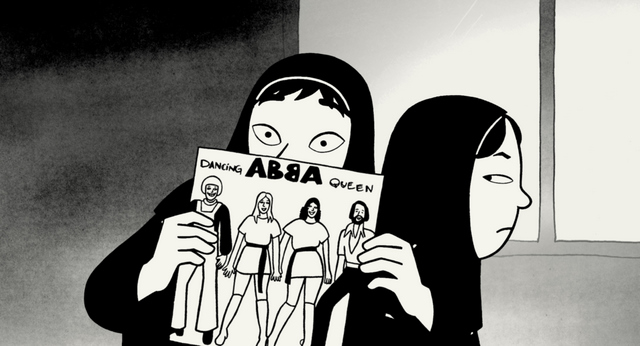JANUARY 25, 2008
Iranian Girl, Interrupted
By Mark Jenkins
Persepolis
Directed by Marjane Satrapi and Vincent Paronnaud

Mullahs's Waterloo: ABBA as cultural revolt (Sony Classics)
A CHARMING YOUTH-REBELLION MEMOIR from the Axis of Evil, Persepolis would be an ideal introduction to contemporary Iran for American audiences -- if only it weren't in French. But Paris-based co-director Marjane Satrapi, who helped adapt the hand-drawn movie from her series of ruefully witty autobiographical graphic novels, has lived in Europe roughly half her life, with French as her adopted native tongue. And if there's one thing Oprah-schooled American audiences should appreciate, it's that Satrapi's film is utterly personal.
Had Satrapi been born someplace further West, Persepolis could be entirely about the insular concerns of American teen flicks: pop culture, adolescent confusion, erotic awakening, and such. Marjane, however, became aware of the larger world just as her family's smaller one was about to be destroyed. In 1978, she's the child of an upscale Tehran couple, and loves Bruce Lee and the Shah of Iran in equal measure. Then the Shah falls, to Marjane's liberal parents's brief-lived delight, and power devolves not to "the proletariat" (as her Uncle Anouche predicts) but to the mullahs.
The film opens in a European airport, where some patches of color contrast Satrapi's simple black-and-white drawings. But Marjane is headed back to Iran, and into the past, realms that suit her alter ego's monochromatic palette. Satrapi and her fellow writer-director, Vincent Paronnaud, bring the novels' panels to life, and fill in some of the blanks with fields of gray. They also borrow such techniques as silhouetting and iris shots from 1920s German Expressionism, another black-and-white form that brilliantly exploited its limitations. Roughly divided between Marjane's 'tween and teen years, Persepolis uses its artless, one-dimensional images to conjure a child's naivete, but also to evoke confinement and oppression. Seas of black ink mutate into various ominous shapes, including a throng of girls suddenly fettered in chadors.
As a child, Marjane accepts her teachers's explanations of God and country. She imagines herself to be a "future prophet," and is offended when anti-Shah demonstrators take to the street. Then her father explains that Iran's ruler is the son of a man put into power by British, who wanted access to the country's oil. Her grandfather was executed by the Shah's secret police, Marjane is told; soon Anouche arrives, fresh from jail, to describe being tortured by CIA-trained interrogators. It's a cursory introduction to post-1953 Iran, but one that could enlighten many Western viewers.
The Shah absconds, the eight-year Iran-Iraq War begins, and in the face of bombings, shortages, and institutionalized misogyny, Marjane becomes a freethinker. Under her chador, she's a fan of punk, loosely defined to include ABBA, Iron Maiden, and Michael Jackson. (Later, Survivor's "Eye of the Tiger" will genuinely inspire her.) Fearing that their outspoken daughter will attract the wrong kind of attention, Marjane's parents dispatch her to a French school in Vienna. Over several years, she's introduced to loneliness, sex, and lying boyfriends. She flees back to Tehran, but that's just a different kind of ordeal. Marjane attends a university, where some things -- such as classes on figurative art in which the figure cannot be unveiled -- are laughably absurd. After an illegal mixed-sex party ends in calamity, Marjane gives Europe one more chance. Color returns, and Iran becomes purely a memory -- much as it is for the beloved straight-talking grandmother she leaves behind.
Family connections are central to Persepolis, and they're underscored by the voice cast: For much of the film, Marjane's lines are spoken by Chiara Mastroianni, and her mother's by Catherine Deneuve, Mastroianni's real mom. The role of Grandma, the film's conscience, is taken by Danielle Darrieux, who played Deneuve's mother in The Young Girls of Rochefort. (Simon Abkarian is Marjane's Dad, and Francois Jerosme is Anouche.) Leaving these performers undubbed will limit the U.S. box office, but it was the right decision. If this movie is fundamentally the story of a maverick forced into exile, the warmth of Marjane's family life is nonetheless palpable.
Persepolis has been hailed at American film festivals, a reception that's a little ironic. A decade ago, the latest movies from Iran's most inteesting directors were routinely booked into U.S. arthouses, but now they're really seen outside the non-profit circuit. It's no criticism of Satrapi to note that Persepolis doesn't especially challenge Western viewers, or evoke the plight of Iranian women as harrowingly as such Jafar Panahi films as The Circle and Offside. Satrapi's movie is the parable, after all, of a girl who begins pretty Westernized, and only becomes more so as she grows up. The film's most potentially controversial scenes are those in which the young Marjane chats with an anthropomorphized supreme being -- blasphemy to Muslims, but just a George Burns routine to us. If Persepolis is a modest stateside hit, that will be in large part due to the film's energy, humor, and poignance, and to its author's candid self-disclosure. But it will also be because the mirror Satrapi holds up to herself reflects so much that's familiar to American filmgoers.